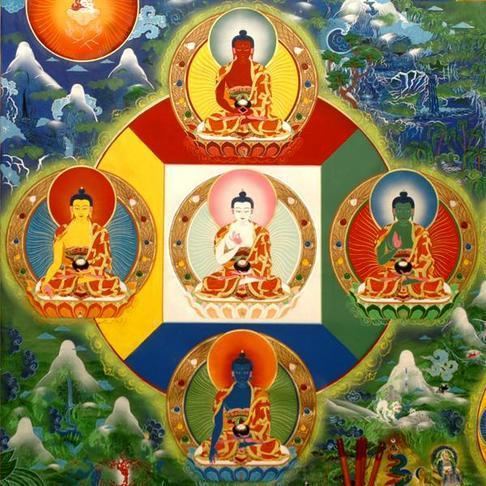 | ||
Explanation of the five wisdoms in tibetan buddhism
The Five Wisdoms are five kinds of wisdoms which appear when the mind is purified of the five disturbing emotions and the natural mind appears. All of those five wisdoms are represented by one of the five buddha-families.
Contents
- Explanation of the five wisdoms in tibetan buddhism
- Five wisdoms five poisons
- Nomenclature orthography and etymology
- Five Wisdoms
- Five Dhyani Buddhas
- References
Five wisdoms five poisons
Nomenclature, orthography and etymology
Pañca-jñāna is orthographically rendered into English as: Five Wisdoms, Five Awarenesses, Five Pristine Cognitions.
Five Wisdoms
The Five Wisdoms are:
- Tathatā-jñāna, the wisdom of Suchness or Dharmadhatu, "the bare non-conceptualizing awareness" of Śūnyatā, the universal substrate of the other four jñāna;
- Ādarśa-jñāna, the wisdom of "Mirror-like Awareness", "devoid of all dualistic thought and ever united with its 'content' as a mirror is with its reflections";
- Samatā-jñāna, the wisdom of the "Awareness of Sameness", which perceives the sameness, the commonality of dharmas or phenomena.
- Pratyavekṣaṇa-jñāna, the wisdom of "Investigative Awareness", that perceives the specificity, the uniqueness of dharmas.
- Kṛty-anuṣṭhāna-jñāna, the wisdom of "Accomplishing Activities", the awareness that "spontaneously carries out all that has to be done for the welfare of beings, manifesting itself in all directions".
The Five Wisdoms "emerge through a transformation (parāvṛtti) of the eight consciousnesses at the moment of enlightenment".
Five Dhyani Buddhas
The idea of the Five Wisdoms "underwent a considerable development" within Tibetan Buddhism where they are "symbolized or embodied" in the Five Dhyani Buddhas.
According to Tenzin Wangyal, the Five Pure Lights become the Five Poisons if we remain deluded, or the Five Wisdoms and the Five Buddha Families if we recognize their purity.
The Five Wisdoms, and the accompanying Five Buddhas, are represented in Tibetan Buddhism by the "symbolic bone ornaments". The Hevajra Tantra associates the Symbolic Bone Ornaments directly with the Five Wisdoms:
- the 'wheel-like' (Tib.: 'khor lo) 'crown ornament' (sometimes called 'crown jewel') (Tib.: gtsug gi nor bu), symbolic of Akshobhya and 'mirror-like pristine awareness' (Ādarśa-jñāna);
- 'earrings' (Tib.: rna cha) represent of Amitabha and pristine awareness of discernment (Pratyavekṣaṇa-jñāna);
- 'necklace' (Tib.: mgul rgyan) symbolizing Ratnasambhava and pristine awareness of total sameness (Samatā-jñāna);
- 'bracelets' (Tib.: lag gdu) and 'anklets' (Tib.: gdu bu) as symbolic of Vairochana and pristine awareness of the ultimate dimension of phenomena (Tathatā-jñāna);
- 'girdle' (Tib.: ske rags) symbolizing Amoghasiddhi and the accomplishing pristine awareness (Kṛty-anuṣṭhāna-jñāna);
The additional ornament spoken of in various texts related to Hevajra is ash from a cremation ground smeared on the body (Tib.: thal chen).
